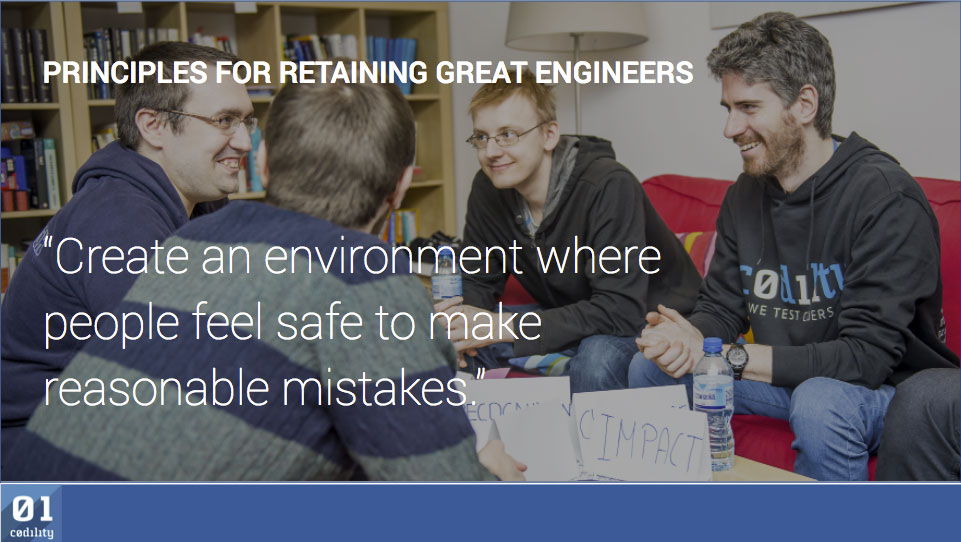The battle for tech talent is fierce, and there’s way more to it than simply convincing candidates to join your ranks. Organizations fighting to win the best people might be focusing too heavily on recruiting and initial hiring – and that’s understandable given how competitive the market is. Top programmers are highly coveted and they know it, often earning multiple offers to choose from. So companies go all out to source, attract, and recruit individuals who can take their products and services to the next level.
But hiring is the first phase of what is, hopefully, a long relationship. Yes, you’ve attracted the right people, and hired them, but what now? It takes a long time to find and hire the right person, so don’t let the excitement and goodwill you created during the hiring process go to waste. Invest in your workplace culture to retain the people you worked so hard to win over.
How do you make this happen? Adhere to these three principles and you’re well on your way to creating a culture great engineers will want to join and remain in.
1. Create A Safe Learning Environment.
Many times hiring managers become too focused on selling compensation packages and perks, potentially overlooking the fact that when candidates consider an opportunity for the long haul, advancement and a sense of purpose are huge factors as well. Of course, it’s hard for anyone to arrive at that level of fulfillment when basic needs aren’t being met.
When thinking about how to create a healthy, positive, and nurturing workplace, psychological safety should be your first priority. If people feel like they’re constantly under pressure, or feel like they are being attacked while working, they won’t be productive or happy. If they feel like a wrong move could get them fired, they won’t take the risks that most often lead to breakthroughs. This advice may seem obvious because employers don’t often assume such egregious issues exist under their roofs.
Because psychological safety is a requirement for any other cultural aspirations, make sure you create an environment where people feel safe to experiment and make reasonable mistakes.
Once you have a safe workplace, a good next step is providing runway for your employees to take off. At Codility, we seek to create an environment that invites people to do their best work. Create a space where they can learn, achieve, and get stuff done on a team that truly empowers them to accomplish all these things.
To craft a work space that inspires and motivates people on my team, I often draw from Dan Pink’s Drive. It’s crucial to focus on these elements:
- Purpose – align your team around a common goal and give everyone a clear way to contribute
- Mastery – create an environment where team members can hone their skills and become better at what they do every day
- Autonomy – empower your team to make as many decisions as possible and give them freedom in combination with alignment to create unified results
I strongly believe these guidelines are the base for creating a great work environment.
Empower employees to master skills so they can work autonomously, and create purpose so they’re motivated to do so.
2. Be Mindful Of Different Personality Types.
Diverse workplaces are proven to be grounds for more productive and effective teams. You want to grow your team with people of all personality types. If you are capable of understanding and communicating with each individual, you will be able to enrich the relationships you have with your team members. In the end, this is what your team will value, and what will make their work more effective.
It’s important to understand your team’s dynamic because each person’s personality adds something to the mix. The two most commonly discussed personality archetypes in the workplace are introverts and extroverts. Spend time observing your team, getting to know each individual, and understanding the social dynamics. You’ll notice that some people tend to be more expressive and dominate in conversation (extroverts), and that others are more reserved and quiet (introverts).
Make sure to create an environment where both extroverted and introverted people have equal chances to verbalize their opinions.
With introverts, you might need to do more nudging or prompting to elicit engagement. Allow them to gather their thoughts and give them space to speak. Create pauses between topics to ask questions, allowing time for the introverts to chime in. It’s OK to ask specific team members for their thoughts from time to time, but don’t overdo it. Often the ones that speak the least have powerful insights and valuable input. Susan Cain explains the power of introverts in her book Quiet.
With extroverts, getting them to speak up usually won’t be the problem. Instead, encourage them to be more reflective – to pause and engage in more balanced two-way conversations. This will also get them to develop good habits for when they interact with the introverts on the team.
Regardless of personality type you’re dealing with, these are things that will help you create a great work environment and build rapport with your team members:
- Actively listen to what your team has to say to you – be a coach and a mentor to them.
- Grow your team members by gradually delegating responsibility.
- Genuinely care about individuals on your team.
- Learn how your team likes to be appreciated – some people like to be appreciated publicly, others don’t.
- Be your real self – don’t try to be someone you’re not just to give off a certain impression. People value genuineness.
3. Build Feedback Loops Into Your Organization.
No workplace is perfect, but that doesn’t mean we can’t strive to continually improve and enhance the culture to bring out the best in people. On top of creating a safe learning environment for your team and understanding team dynamics, you need to create communication channels to allow information to flow across all parts of your organization.
Smaller organizations have an easier time creating flat hierarchies where information flows easily in any direction. But as your team grows, this will become more challenging to maintain. It is crucial to build feedback loops so that you receive information from team members about what’s working and what needs to be fixed.
Here are some great ways to do that:
- 1 on 1 meetings are a core part of the Codility culture. For 1 on 1s to be effective, they need to be regular, frequent, and follow a set format. I’ve learned a ton about this from One on One by Ben Horowitz and The Update, The Vent, and The Disaster by Michael Lopp.
- 360 degree feedback allows individuals to receive feedback from peers, managers, and direct reports.
- Surveys are a great way to get feedback from many people quickly and anonymously. Actively gathering feedback about large team meetings or other events can greatly improve their effectiveness and ensure everyone gets value out of them.
- Genchi Genbutsu, which translates to “go and see for yourself”, is a mentality that helps larger organizations support their multitude of hierarchical layers. In order to understand what’s going on in their teams, leaders should regularly spend time on the floor where things are taking place.
- Officevibe gives you quantitative feedback on your workplace. At Codility, we use the data to see trends around important aspects of team health.
One method that I would not recommend is the open door policy alone. Even though it sounds like a good mechanism for your team members to express what’s bothering them, it might be difficult for them to actually do so. It’s much easier for individuals to raise an issue when asked questions aimed to improve the situation than to proactively bring up problems seemingly out of the blue.
Each of these methods allows information to flow across your organization in a different way. To achieve an organization you feel has a great culture of open communication and feedback, experiment with implementing few of them at a time and fine-tune as you go.
At the end of the day, we want the people we hire to be smarter than us. We want to learn from them and improve the overall organization. If we can authentically provide people with the license to give honest feedback, we can start to make some really positive changes. It’s true; some people aren’t good at giving feedback when they first start out, or maybe their previous company ruled with an iron first. But all the patience and dedication you commit to building feedback loops is worth it because the resulting organization is more self-aware and self-improving.
You can find Codility on the SmartRecruiters Marketplace. For a free trial of Codility, click here.











